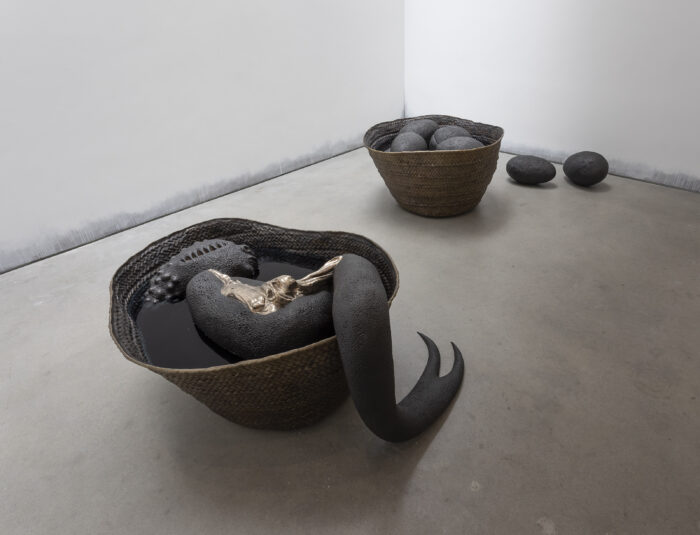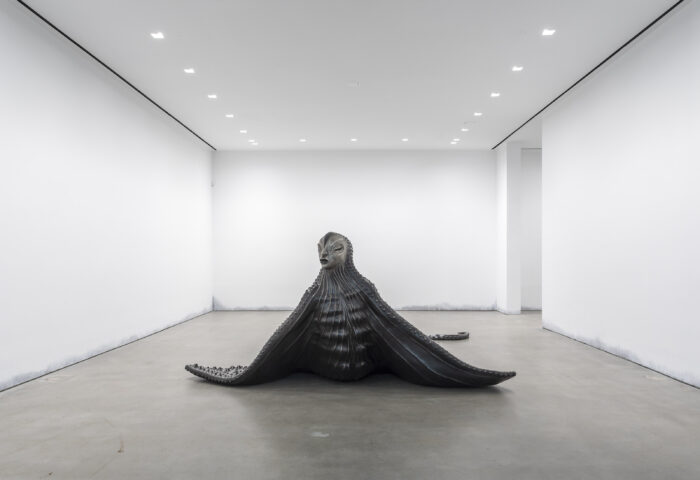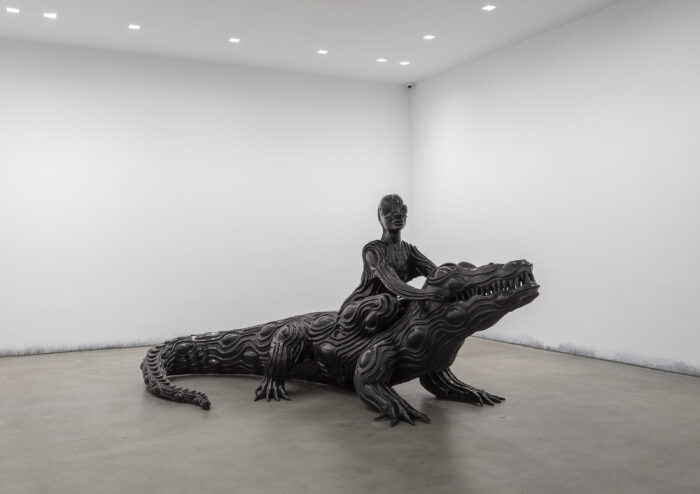
Wangechi Mutu at Gladstone Gallery
May 6 – June 25, 2021
515 West 24th Street
Mid-career, Ghanian-American artist Wangechi Mutu has made a name for herself as the creator of usually disfigured, collaged paper portraits of women, which incorporate her African heritage as well as her interest in such things as medical texts on facial disease. Porn also makes its way into her work. Her art asserts a determined effort to look at what constitutes beauty and strength in women in a time when traditional notions of these attributes are being challenged. Now, in a recent, major change from her traditional image-making, Mutu is presenting bronze sculptures in a decision to communicate feminine disquiet in a more permanent, three-dimensional fashion. But the element of psychic trouble, as well as the artist’s predilection for disturbing visuals, remain part of her idiom: there is a strikingly horrific, large vision of a creature that is part woman, part manta ray, as well as another woman riding an oversize crocodile–a language incorporating visual alienation in dissent with received notions of female beauty, or modesty or reticence, for that matter.
Behind the assertiveness of such imagery is, I think, a sincere attempt to find a new language that would substitute for the male-affirming mythology we have been living with for a very long time. Women are refusing their secondary roles, in culture especially. One assumes that Mutu, a foreign-born woman of color, would be particularly sensitive to the negative nuances historically associated with someone of her background. Indeed, the collages present her ongoing investigation of certain clichéd tropes of attractiveness. Still, creating new visual images representing a new understanding of the female role, not without aggression, is a difficult task. It is a major part of current gender politics, in which men’s priorities are being questioned. Mutu’s decision to set her vision in bronze indicates her wish to develop a permanent vehicle for a current feminist outlook. But even should the sculptures be ideologically driven, they need to visually succeed–and in the case of this show, they do. The horrific has always been part of the mythological drive, and this is something Mutu knows well. By introducing imagery that is unreasonable, such as a part-female, part-aquatic creature, or a woman riding a carnivorous reptile, Mutu introduces a world in which boundaries collapse.

MamaRay (2020), is a large reproduction of the manta ray, but with a head of a woman whose longish hair shows off tight curls and descends down the middle of her forehead. Her eyes are closed, but the expression isn’t quite right–the face is almost a mask despite the human features. Her eyes are heavily lidded, and her torso consists of circular ribs without any break between them, and while there are no arms or legs, the ray’s body–cape-like with studs, ending with a long tail–envelops the female head. The image is larger than life and more than a bit menacing. It looks like the artist wants to create a threatening female power, linked to the sea and its more dangerous creatures (actually the manta ray is incapable of stinging). By merging the ray with a woman’s features, Mutu is developing a visual expression that involves the human with inhuman power–from a female perspective. In Crocodylus (2020), a woman, again with heavy-lidded eyes, rides the back of an enormous crocodile. Her legs cannot be seen; they must be embedded in the belly of the beast. Her hands grip the animal’s teeth furthest back in its mouth. Despite the danger, her countenance is calm, detached. Once again, this feels like an attempt on Mutu’s part to revise the traditional emotional state of the woman as timid or fearful. Here she rides a huge reptile with ease, inserting her fists into its mouth of jagged teeth. One can hardly imagine a more prodigious scene.

In the long run, efforts by Mutu and other female artists to revise mythologies from a woman’s point of view are meant to build another outlook on culture, in which women command their own presence in powerful ways. We can’t erase the past, but we can create an updated current vision of women as personages of great strength. Mutu does a very good job here of devising images that are partly female, partly savage. Her use of frightening or dangerous creatures to make her point is intended to invoke both fear and awe. Instead of alluding to the contemporary politics of gender, she looks to the nearly ageless perspective of the mythic narrative. What does the story mean? It means that stereotypes of women must change, in light of their merger with fierce creatures from warm waters.
